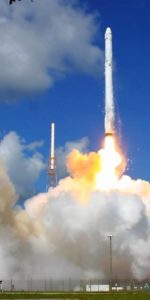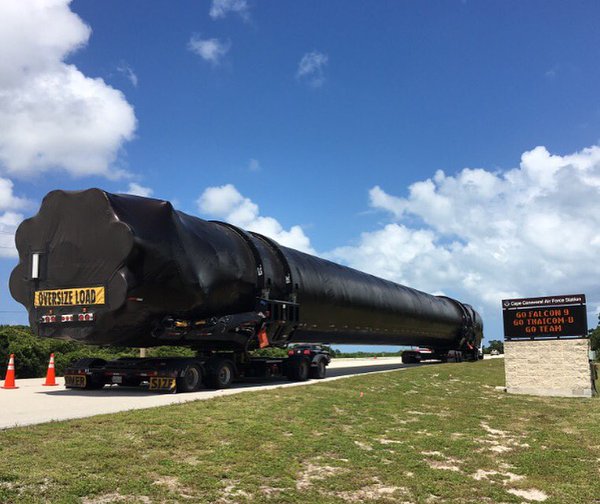
If all goes according to plan, the morning of Wednesday, 15 June, should bring a pinch of déjà vu for SpaceX, as the Hawthorne, Calif.-headquartered launch services organization aims to deliver a pair of familiar-sounding satellites to Geostationary Transfer Orbit (GTO). Eutelsat 117 West B, flying on behalf of the French-led European Telecommunications Satellite Organisation, and ABS-2A, lofted for Bermuda-based Asia Broadcast Satellite, will be the second such pairing launched on the same mission by SpaceX, following the Eutelsat 115 West B and ABS-3A double-deployment mission last March. If it flies as intended, the mission will tie with 2014 and 2015 for the greatest number of flights executed successfully in a single calendar year by SpaceX, which brought its Upgraded Falcon 9 booster into operational service last fall. Liftoff of the sixth Upgraded Falcon 9 is targeted during a 45-minute “window,” which according to SpaceX opens at 10:29 a.m. EDT Wednesday.
FOLLOW our on-site reporting and Eutelsat 117 West B/ABS-2A Launch Tracker for regular updates, as well as LIVE coverage on launch day.
The first six months of 2016 have exhibited impressive pace, kicking off with the swansong of the workhorse Falcon 9 v1.1, which transported NASA’s Jason-3 ocean altimetry payload aloft in January. This was followed by a trio of heavyweight commercial communications satellites—SES-9 in March and last month’s JCSat-14 and Thaicom-8—bound for 22,300-mile (35,900-km) GTO locations. Dovetailed into this haul of missions was the resumption, in April, of Commercial Resupply Services (CRS) cargo flights to the International Space Station (ISS), with the CRS-8 Dragon. Adding further drama to these missions were three successful back-to-back landings of Upgraded Falcon 9 first-stage cores on the Autonomous Spaceport Drone Ship (ASDS) in the Atlantic Ocean.
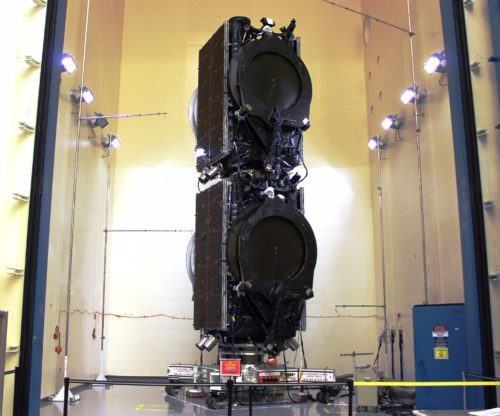
On the very day (27 May) that Thaicom-8 launched, SpaceX welcomed the first stage of its next Upgraded Falcon 9, tasked with the Eutelsat 117 West B and ABS-2 double-deployment mission. At its base, the first stage houses a suite of nine Merlin 1D+ engines, capable of 1.5 million pounds (680,000 kg) of propulsive yield at T-0. It was transported to the Horizontal Integration Facility (HIF) at SLC-40, where it was mated to the second stage—which is powered by a single Merlin 1D+ Vacuum engine, with a thrust of 210,000 pounds (95,250 kg)—and the bulbous Payload Fairing (PLF). The latter is a two-piece (“bisector”) affair, which encapsulates the satellites and will be jettisoned at the edge of space by means of a pair of pneumatic “pushers.”
Contracts to fabricate Eutelsat 117 West B and ABS-2A were signed in March 2012, when Boeing was awarded a four-satellite contract, together with options for four others, through a joint procurement by ABS and Mexico City-based Satélites Mexicanos (Satmex). However, in early 2014, Satmex was procured by Eutelsat, renamed “Eutelsat Americas,” and the former Satmex satellite names were realigned with the Eutelsat brand. The first two members of the contract—ABS-3A and Eutelsat 115 West B (previously “Satmex-7”)—were launched to GTO by a Falcon 9 v1.1 booster, last 1 March. Meanwhile, in July 2013, the second pair of satellites were ordered and identified as ABS-2A and Satmex-9. With the procurement of Satmex by Eutelsat, Satmex-9 was renamed “Eutelsat 117 West B.”
All four satellites are based upon Boeing’s BSS-702SP (“Small Platform”) bus, which employs an all-electric propulsion system, thereby freeing up volume for payloads and reducing overall mass by eliminating the need for a chemical propulsion system. The development of the BSS-702SP got underway in 2012, passed smoothly through its Critical Design Review (CDR) the following year, and each spacecraft is assembled at Boeing Defense & Space’s Satellite Development Center in El Segundo, Calif. Measuring 15 feet (4.6 meters) tall and 7 feet (2.1 meters) in diameter, the cylindrical bus carries a pair of electricity-generating solar arrays, as well as lithium-ion batteries and a state-of-the-art attitude determination and control system with star trackers, Earth sensors, and reaction wheels. This allows it to support a payload power range from 3-8 kilowatts. Weighing around 3,970 pounds (1,800 kg) at launch, the BSS-702SP is sufficiently low in mass for two satellites to fly atop the same booster.
And this capability was demonstrated in March 2015, when ABS-3A and Eutelsat 115 West B rocketed into orbit atop SpaceX’s Falcon 9 v1.1. The two satellites were stacked, one atop the other. After the conclusion of first-stage flight, the second stage performed an initial “burn,” lasting six minutes, then entered a 16-minute period of coasting, ahead of a shorter second burn, which established the payloads into a “parking” orbit. During this time, the PLF was jettisoned. Upon the termination of the second burn, the ABS-3A payload was deployed at T+30 minutes, after which the second stage executed a “Reorientation Between Separation Events” maneuver, and Eutelsat 115 West B was deployed at T+35 minutes.
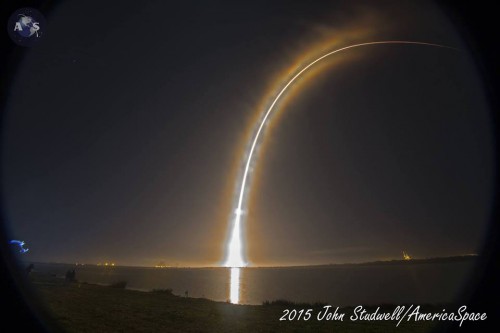
It is expected that Wednesday’s flight of Eutelsat 117 West B and ABS-2A will follow a similar flight regime. After deployment, the satellites will employ their electric propulsion systems to deliver themselves from the initial transfer orbit into their operational GTO locations. The electric propulsion systems on each BSS-702SP bus comprises a quartet of 9.8-inch (25 cm) thrusters, with a limited specific impulse of 3,400-3,500 seconds.
As its name implies, Eutelsat 117 West B is destined to occupy an orbital “slot” at almost 117 degrees West longitude—116.8 degrees, to be precise—where it will be co-located with Eutelsat 117 West A. The latter was launched atop a Russian Proton-M booster in March 2013, under its original name of “Satmex-8,” but has since been redesignated in accordance with the Eutelsat Americas branding. West A’s expansive communications payload of 24 C-band and 40 Ku-band transponders has enabled it to provide broadband, voice and data transmission, and video broadcasting services across 45 nations and territories in the Americas. Specific focal regions include Mexico, the Andes, Central America, and the Caribbean Sea, together with large areas of South America.
The arrival of West B will bring online a satellite with 48 Ku-band transponders, capable of serving all of the former Satmex’s Latin American customers in the video, telecommunications, and government sectors. Specifically, the new satellite will provide capacity for Satmex’s direct-to-home and telecommunications clients. Additionally, Eutelsat 117 West B carries a Wide-Area Augmentation System (WAAS), which will allow the Federal Aviation Administration (FAA) to enhance aviation safety.
Physically identical to Eutelsat 117 West B is ABS-2A, which will be co-located at 75 degrees East longitude with the ABS-2 satellite. The latter was delivered to GTO atop an Ariane 5 booster in February 2014, tasked with providing direct-to-home and cable television, as well as data networks and telecommunications coverage, for 60 percent of the world’s population, spanning Russia, North Africa, Asia, and the Middle East. The arrival of ABS-2A will bring 48 transponders and five high-powered Ku-band beams to provide coverage of South Asia, Southeast Asia, Russia, Sub-Saharan Africa, and the Middle East and North Africa (MENA) region.
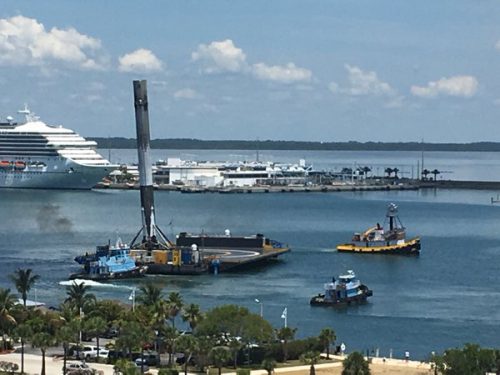
According to the 45th Weather Squadron in its Friday morning update, Tuesday, 14 June (primary), and Wednesday, 15 June (backup), were both expected to be favorable, with an 80-percent likelihood of acceptable meteorological conditions for an on-time launch. Citing the 20-percent risk of violating the Cumulus Cloud Rule on both days, the 45th noted that a boundary over Central Florida in recent days—which had already thwarted the first attempt by United Launch Alliance (ULA) to fly its mammoth Delta IV Heavy with the National Reconnaissance Office’s NROL-37 classified payload on Thursday, 9 June—had focused thunderstorms across the Space Coast. This was expected to dissipate over the weekend, bringing drier weather and a reduced threat of lightning by the first half of the new week. “On Tuesday, a more typical summer pattern begins to set up with light southwesterly flow, holding off the sea breeze thunderstorms until after launch time,” it was explained. “On Wednesday, the southwesterly flow is stronger over the Space Coast and will also hold off the sea breeze until after the launch window.” On both primary and backup days, maximum upper-level winds from the northwest are expected to reach 20 knots at 30,000 feet (9,000 meters).
However, on Saturday, SpaceX announced that it would aim instead for the second of these opportunities, with a projected T-0 at 10:29 a.m. EDT Wednesday. Weather was expected to remain at 80-percent favorable. In readiness for this launch attempt, the nine Merlin 1D+ first-stage engines were put through a standard Static Fire Test on Sunday, 12 June. The test ran without incident.
In spite of the similarities between Wednesday’s mission and the Eutelsat/ABS double-deployment mission of March 2015, there are a number of differences. Chiefly, the 229-foot-tall (70-meter) Upgraded Falcon 9 benefits from a significantly shorter fueling regime than its predecessor, the v1.1, with loading of its “densified” cryogenic propellants typically beginning only 35 minutes before liftoff. Finally, at T-13 minutes, a final “Go/No-Go” poll of all 13 flight controllers will be undertaken by the Launch Director. Satisfactory passage through this poll will allow for the start of the Terminal Count at T-10 seconds.
The final minutes before any Upgraded Falcon 9 launch are a hive of activity, characterized by the chilling-down of the nine Merlin 1D+ engines, the disconnection of all external utilities from the Ground Support Equipment (GSE), and the transitioning of the payloads to internal power. At T-5 minutes, the “strongback” will be retracted from the vehicle, after which the Flight Termination System (FTS) will be armed and propellant tanking will conclude. Sixty seconds before launch, the “Niagara” deluge system of 53 nozzles will flood the SLC-40 pad surface with 30,000 gallons (113,500 liters) of water per minute to suppress acoustic energy from the Merlin 1D+ exhausts. Simultaneously, the booster will enter “Startup,” as its on-board computers assume primary command of all critical functions.
Rising from the pad under the combined impulse of 1.5 million pounds (680,000 kg) from its nine first-stage engines, the Upgraded Falcon 9 has 45 minutes—from 10:29 a.m. EDT through to around 11:14 a.m. EDT—on Wednesday to launch. Immediately after clearing the tower, it will perform a pitch, roll, and yaw program maneuver to establish itself onto the proper flight azimuth to inject its twin satellite payloads into orbit. About 2.5 minutes after liftoff, the first stage will shut down and progress through its own series of re-entry and landing burns, targeting a precision touchdown on the deck of the ASDS, affectionately nicknamed “Of Course I Still Love You.”
For the drone ship, the last few weeks have been a series of rapid-fire trips out of Port of Cape Canaveral to a position about 410 miles (680 km) offshore, in the Atlantic Ocean, to recover the Upgraded Falcon 9 first stages from the CRS-8 Dragon, JCSat-14 and Thaicom-8 launches. Having successfully supported its third consecutive landing on 27 May, the ASDS returned to Port of Cape Canaveral—via the tug Elsbeth III—at 11:33 a.m. EDT on 2 June. Eight days later, at 11:58 a.m. EDT on Friday, 10 June, the drone ship moved again out of port, bound to capture its fourth Falcon in less than 70 days.
Want to keep up-to-date with all things space? Be sure to “Like” AmericaSpace on Facebook and follow us on Twitter: @AmericaSpace




